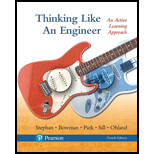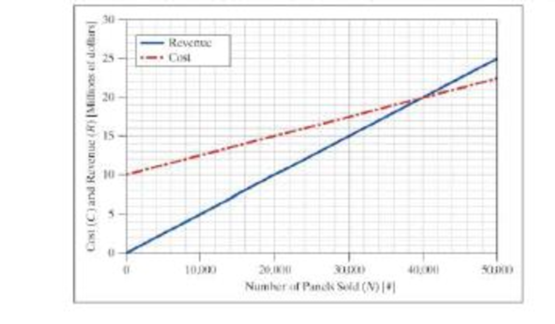
Concept explainers
One of the 14 Grand Challenges for Engineering as determined by a National Academy of Engineering committee is “Make Solar Energy Economical.” According to the NAE website: The solar “share of the total energy market remains rather small, well below 1 percent of total energy consumption, compared with roughly 85 percent from oil, natural gas, and coal ... today’s commercial solar cells ... typically convert sunlight into electricity with an efficiency of only 10 percent to 20 percent... Given their manufacturing costs, modules of today s cells... would produce electricity at a cost roughly 3 to 6 times higher than current prices ... To make solar economically competitive, engineers must find ways to improve the efficiency of the cells and to lower their manufacturing costs.”
The following graph shows a breakeven analysis for a company panning to manufacture modular photoelectric panels. A copy of this graph has been provided online; you may use one of these graphs or use graph paper as directed by you instructor.
- a. What is the fixed cost incurred in manufacturing the photoelectric panels?
- b. How much does it cost to manufacture each photoelectric panel?
- c. What is the sale price of one photoelectric panel?
- d. If the company makes and sells 30,000 panes, is the-e a net loss or profit, and how much?
While the company is still in the planning stages, the government starts a program to stimulate the economy and encourage green technologies. In this case, the government agrees to reimburse the company $250 for each of the first 10,000 units sold.
- e. Sketch a modified revenue curve for this situation.
- f. Using this new revenue curve, how many units must the company make to break even’ Be sure to clearly indicate this point on the graph.

- g. Also using the new revenue curve, how many units must the company make and sell to make a profit of $1,500,000? Be sure to clearly indicate this point on the following graph.
Want to see the full answer?
Check out a sample textbook solution
Chapter 11 Solutions
Thinking Like an Engineer: An Active Learning Approach (4th Edition)
Additional Engineering Textbook Solutions
Thermodynamics: An Engineering Approach
Automotive Technology: Principles, Diagnosis, And Service (6th Edition) (halderman Automotive Series)
Fluid Mechanics: Fundamentals and Applications
Mechanics of Materials (10th Edition)
Java: An Introduction to Problem Solving and Programming (8th Edition)
Starting Out with Programming Logic and Design (5th Edition) (What's New in Computer Science)
- Copyright 2013 Pearson Education, publishing as Prentice Hall 2. Determine the force that the jaws J of the metal cutters exert on the smooth cable C if 100-N forces are applied to the handles. The jaws are pinned at E and A, and D and B. There is also a pin at F. E 400 mm 15° D B 30 mm² 80 mm/ 20 mm 15° $15° 20 mm 400 mm 15° 100 N 100 N 15°arrow_forwardDraw for it make a match which directionarrow_forwardQ.1) Block A is connected to block B by a pulley system as shown. The weights of blocks A and B are 100 lbs and 70 lbs, respectively. Assume negligible friction between the rope and all pulleys as well as between block B and the incline and neglect the mass of all pulleys and cables. Determine the angle 0 required to keep the system in equilibrium. (At least two FBDs must be drawn for full credit) B Ꮎ 000arrow_forward
- pls solvearrow_forward+1. 0,63 fin r= 0.051 P The stepped rod in sketch is subjected to a tensile force that varies between 4000 and 7000 lb. The rod has a machined surface finish everywhere except the shoulder area, where a grinding operation has been performed to improve the fatigue resistance of the rod. Using a 99% probability of survival, determine the safety factor for infinite life if the rod is made of AISI 1080 steel, quenched and tempered at 800°c Use the Goodman line. Does the part fail at the fillet? Explainarrow_forwardSolve this problem and show all of the workarrow_forward
- I need drawing solution,draw each one by one no Aiarrow_forwardQu. 17 Compute linear density values for [100] for silver (Ag). Express your answer in nm''. . Round off the answer to three significant figures. Qu. 18 Compute linear density value for [111] direction for silver (Ag). Express your answer in nm'. Round off the answer to three significant figures. Qu. 19 Compute planar density value for (100) plane for chromium (Cr). Express your answer in nm?. Round off the answer to two significant figures. Qu. 20 Compute planar density value for (110) plane for chromium (Cr). Express your answer in nm ≥ to four significant figures. show all work please in material engineeringarrow_forward3-142arrow_forward
 Refrigeration and Air Conditioning Technology (Mi...Mechanical EngineeringISBN:9781305578296Author:John Tomczyk, Eugene Silberstein, Bill Whitman, Bill JohnsonPublisher:Cengage Learning
Refrigeration and Air Conditioning Technology (Mi...Mechanical EngineeringISBN:9781305578296Author:John Tomczyk, Eugene Silberstein, Bill Whitman, Bill JohnsonPublisher:Cengage Learning
